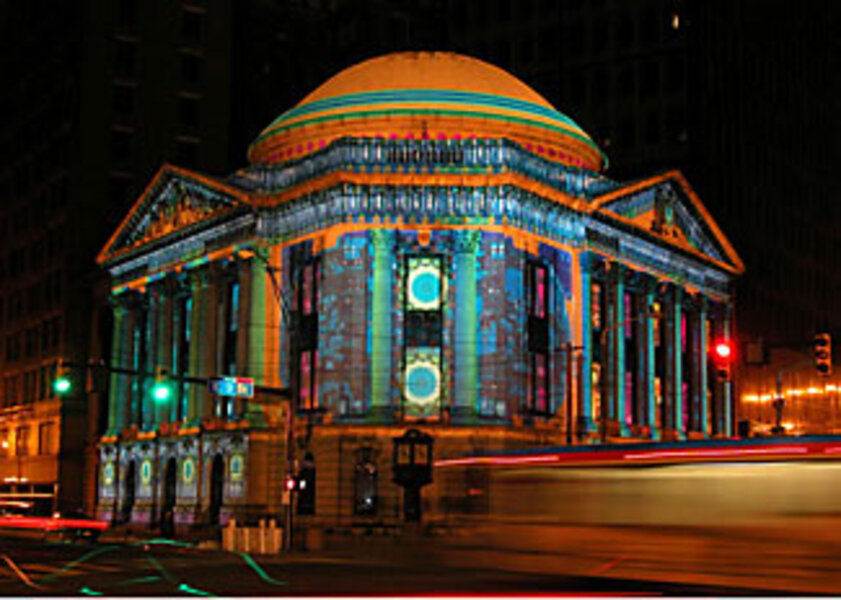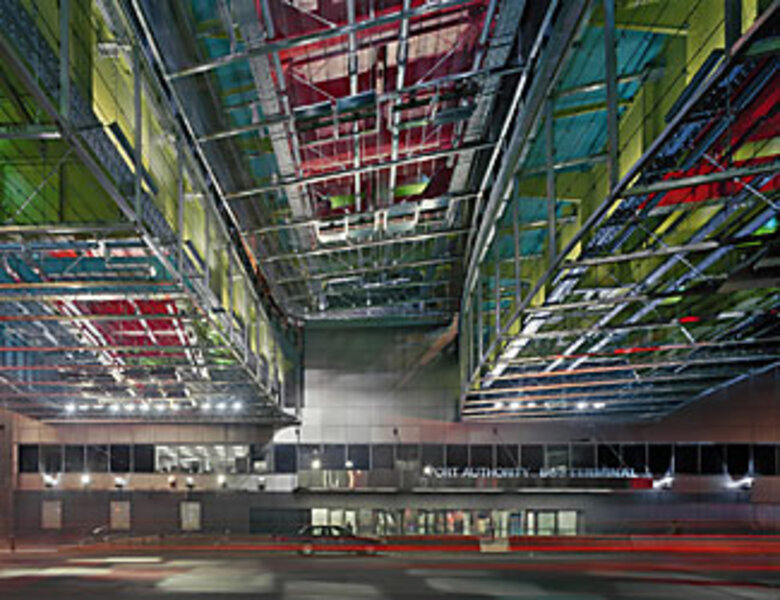Cities shed artful light on the canvas of night
Loading...
Few art forms rival lighting – with its capacity to alter mood, focus attention, or invite wonder. For most of human history, illumination depended on a source of fire, and public lighting displays were as infrequent and fleeting as fireworks on the Fourth of July. Today, artists possess the technology to raise lighting to unprecedented levels, both in their art and in the streets.
Light serves a number of purposes, not the least of which is to enable us to move around safely at night. But after that basic requirement is met, artists have found themselves looking for new uses for light, whether in single installations or large-scale displays found in lighting festivals. Some have gone so far as to join with municipalities and urban planners to bring lighting design to the table, along with architecture, as a means of improving a city's character and livability.
Lighting designer Duilio Passariello in Madrid says his goal is to bring out the flavor of each location and turn that flavor into a "nocturnal feature."
"We're obsessed with lighting the horizontal plane because we view lighting as mostly functional, but rarely for the visual pleasure of the inhabitants," he writes in an e-mail. Such thinking moves lighting from an afterthought to a central role. Where once lighting was static and uniform, now it has the flexibility to set a mood or broadcast the city's identity across the skyline.
This holistic approach to illuminating cities has come to be known as a lighting master plan. While few cities outside Europe have a plan currently in place, the steps involved in creating one help officials evaluate how the layers of lighting – street-level, marquees and directional signage, and monuments or cultural landmarks – should work together and be energy efficient.
Often, the first glimmer of a future role for lighting design appears during a festival, such as those increasingly held around the world, particularly in December. The grand dame of all celebrations is the Festival des Lumières (Festival of Lights) held in Lyon, France, since 1850. What started with hundreds of flickering candles in windows has evolved into a four-day event that showcases the talents of dozens of international artists and brings 4 million visitors to the city.
At the Festival des Lumières, building facades become moveable feasts of color and familiar landmarks take on an animated aspect. Street performances and music round out the celebration, and people are seen strolling and admiring the magically transformed cityscape.
Lyon's experience with the festival carries over into an advisory role to other cities. In 2002, an association was formed to connect professionals and others interested in bringing coherence to urban planning, called LUCI (Lighting Urban Community International). Today, LUCI counts about 60 member cities; nearly 20 of them host some kind of festival.
"A light festival is easier to promote than a [lighting] master plan," says Alexandre Colombani, general manager of LUCI. A plan often requires considerable effort and money to launch, and once it's in place, it may be invisible to the average citizen.
An example of a master plan on a smaller scale can be seen in the Quartier des Spectacles in Montreal, Quebec, where the city has harnessed the power of light to create a distinct identity for an arts and cultural district.
"We are looking to brand a territory," says Frédéric Bove, manager of the master plan. "We do this on a double level: a lighting signature [a carpet of red dots on the pavement to show the way] and architectural lighting that enhances a facade and reveals the activity within." The lighting is never the same twice, and can be programmed for a particular moment, such as when the theater lets out, to guide patrons to a nearby restaurant or attraction.
Such sophisticated lighting schemes are possible because of advances in technologies such as LEDs (light-emitting diodes) and especially electronic controls. Sensors can transmit information from a variety of stimuli: the motion of pedestrian and vehicle traffic, ocean tides, weather, and the passing of time.
"People enjoy having light follow them as they walk," says Leni Schwendinger of Light Projects Ltd. in New York. "There's a one-on-one interaction." But to take lighting to the next level, "the light can't just be sympathetic, it has to be contrapuntal," she says. Think of light as music, with the simplest formula being one step equals one melody, as opposed to the more complex musical notion of counterpoint, in which additional melodies come in above or below the existing melody, as in a Bach canon. [Editor's note: The original version misspelled Ms. Schwendinger's last name.]
Light as it's generally used lacks this type of nuance.
"Cities are expanding, so that the city edge, which was once oriented toward industry or transportation, is now in the center," says Ms. Schwendinger. "We're brought in to humanize sites that are neglected, to make them more friendly and, hopefully, more provocative."
She recently completed a large-scale, permanent installation for New York's Port Authority bus terminal, called "Triple Bridge Gateway." The terminal, which is the largest bus station in the United States and serves about 55 million riders a year, uses a system of ramps to move buses and people. Cars drive under these ramps, which were once a no man's land of ugly metal I-beams. Schwendinger designed a colored lighting pattern on metal mesh that not only illuminates the underside of the terminal, but also projects patterns onto the street below. The result is a kaleidoscope of colors that transforms the terminal and reconnects two Manhattan neighborhoods.
Not everyone agrees that colorful lighting displays improve a city. "Just because we have LEDs in all the colors of the rainbow, does that mean we have to use them?" asks Pete Strasser, managing director of Dark Skies, a group in Tucson, Ariz., that advocates reducing light pollution. He quotes detractors who call such lighting designs "spilled Kool-Aid." Instead, he supports architectural lighting that reveals a building's features in a subtle way. "It's appropriate for cities to take pride in their buildings, but the structures don't have to be lit all night, they can be dimmed," he adds.
Artists see their role as reengaging people with their cities. "The surprising factor is that the US is still discovering this tool," says Lucette de Rugy, a French lighting designer in New York whose company, Art Lumière, has applied a painterly touch to facades from Geneva to Dallas. While a number of American cities host light festivals, the idea of reinvigorating downtowns or shopping districts with light has not really caught on yet.
Schwendinger sees this attitude shifting. "The field of lighting design is still in its adolescence," she says. More designers need to understand the process and work with municipal officials and architects to frame a shared vision of what cities can offer their citizens after dark. "There are as many shades of night as there are of daylight," she says.







